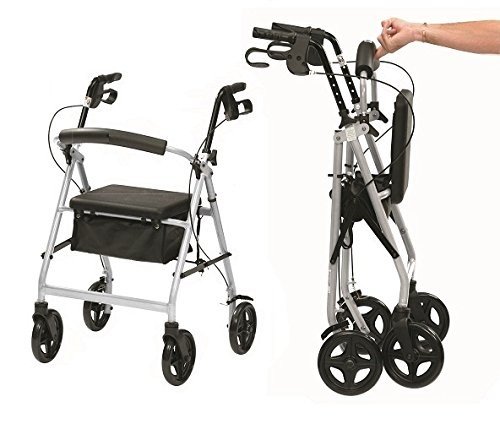
Compact Rollator
Add a review FollowOverview
-
Founded Date Juli 15, 1945
-
Posted Jobs 0
-
Viewed 50
Company Description
See What Walking Aids Tricks The Celebs Are Making Use Of
Walking Aids: Enhancing Mobility and Independence
Walking aids are essential tools developed to help people with mobility obstacles, enabling them to move easily and conveniently. These devices can considerably improve autonomy, improve posture, lower the danger of falls, and boost general quality of life. This short article delves into various kinds of walking aids, their benefits, considerations for use, and pointers for choosing the ideal aid. In addition, a thorough FAQ area addresses typical questions about walking aids.
Kinds Of Walking Aids
Walking aids been available in different types to cater to different needs and preferences. Below is a categorized list of the most typically utilized walking aids:
1. Walking canes
- Standard Canes: A single straight walking cane for fundamental assistance.
- Quad Canes: Canes with a four-pronged base for increased stability.
2. Walkers
- Standard Walkers: Frame-like gadgets that supply assistance on all sides, terrific for those with limited strength.
- Rolling Walkers (Rollators): Equipped with wheels, these permit users to walk with less effort and come with seats for resting.
3. Crutches
- Axillary Crutches: Used under the arms; appropriate for short-term mobility concerns.
- Forearm Crutches (Lofstrand Crutches): Designed for long-lasting use, they require grip strength and are lighter than axillary crutches.
4. Wheelchairs
- Handbook Wheelchairs: Require user effort to move, offering flexibility and self-reliance.
- Electric Wheelchairs: Battery-powered choices suitable for users with limited arm strength.
Benefits of Walking Aids
Walking aids provide various advantages that contribute to enhanced mobility, safety, and self-reliance. Some key benefits include:
- Increased Stability: Walking aids provide additional points of contact with the ground, reducing the threat of falls.
- Boosted Mobility: They enable movement over greater ranges, allowing people to take part in social activities and day-to-day tasks.
- Discomfort Reduction: Properly fitted walking aids can relieve pressure on joints and reduce pain related to various medical conditions.
- Improved Confidence: Using a walking aid can increase an individual’s self-confidence, motivating them to explore their environment without fear.
- Posture Support: Aids assist maintain correct alignment and posture, reducing pressure on the back and hips.
Considerations When Choosing Walking Aids
Selecting the right walking aid is crucial for safety and effectiveness. Here are some aspects to think about:
1. Private Needs
- Assess the level of help required for mobility.
- Consider whether short-term or long-term assistance is needed.
2. Environment
- Assess the surface and surface areas (indoor vs. outdoor) where the aid will be used.
- Make sure that the walking aid is suitable for stairs, ramps, or irregular surface areas.
3. Weight and Portability
- Examine the weight of the walking aid and if it can be transported easily.
- Lightweight choices are more suitable for those who might require to lift or stow the aid frequently.
4. Convenience and Fit
- Make sure the walking aid is adjustable and fits the user’s height.
- Consider grips, armrests, or seats that offer convenience for extended use.
5. Budget
- Figure out a budget for the walking aid while thinking about the quality and features required for the user’s safety and convenience.
Frequently Asked Questions About Walking Aids
1. Who should use walking aids?
Walking aids appropriate for individuals recuperating from surgical treatment, those with persistent discomfort, seniors experiencing balance issues, or anyone with a mobility difficulty.
2. How do I pick the best height for a walking aid?
When standing directly with great posture, the top of the walking stick or walker must align with the wrist bone. A health care specialist can provide guidance during fitting.
3. Can I use a walker on stairs?
While it’s normally not safe to use a walker on stairs, some walkers are designed particularly for stairs with features that enhance stability. Constantly seek advice from with a physical therapist for tailored guidance.
4. How can I keep my walking aid?
Frequently look for loose parts, wear and tear, and tidy the gadget according to the manufacturer’s guidelines to ensure safety and longevity.
5. Do walking aids aid with balance?
Yes, walking aids can provide the required support and stability, assisting to avoid falls and assist with well balanced movement.

Walking aids are invaluable devices that empower people with mobility difficulties to maintain self-reliance and enhance their quality of life. By understanding the different kinds of walking aids, their benefits, and vital factors to consider for choice, users can make informed choices customized to their needs. Whether for momentary assistance or long-lasting use, the ideal walking aid can transform daily routines and boost general wellness.
| Kind Of Walking Aid | Functions | Best For |
|---|---|---|
| Walking canes | Single or quad bases | Moderate assistance |
| Walkers | Fixed or rolling alternatives | Lower body weakness |
| Crutches | Axillary or forearm designs | Short-term mobility issues |
| Wheelchairs | Manual and electrical options | Serious mobility limitations |
Accepting the right walking aid can result in newfound liberty and a more active way of life, promoting self-reliance and social engagement. As constantly, assessments with health care professionals can offer tailored recommendations to make sure safety and effectiveness in using walking aids.